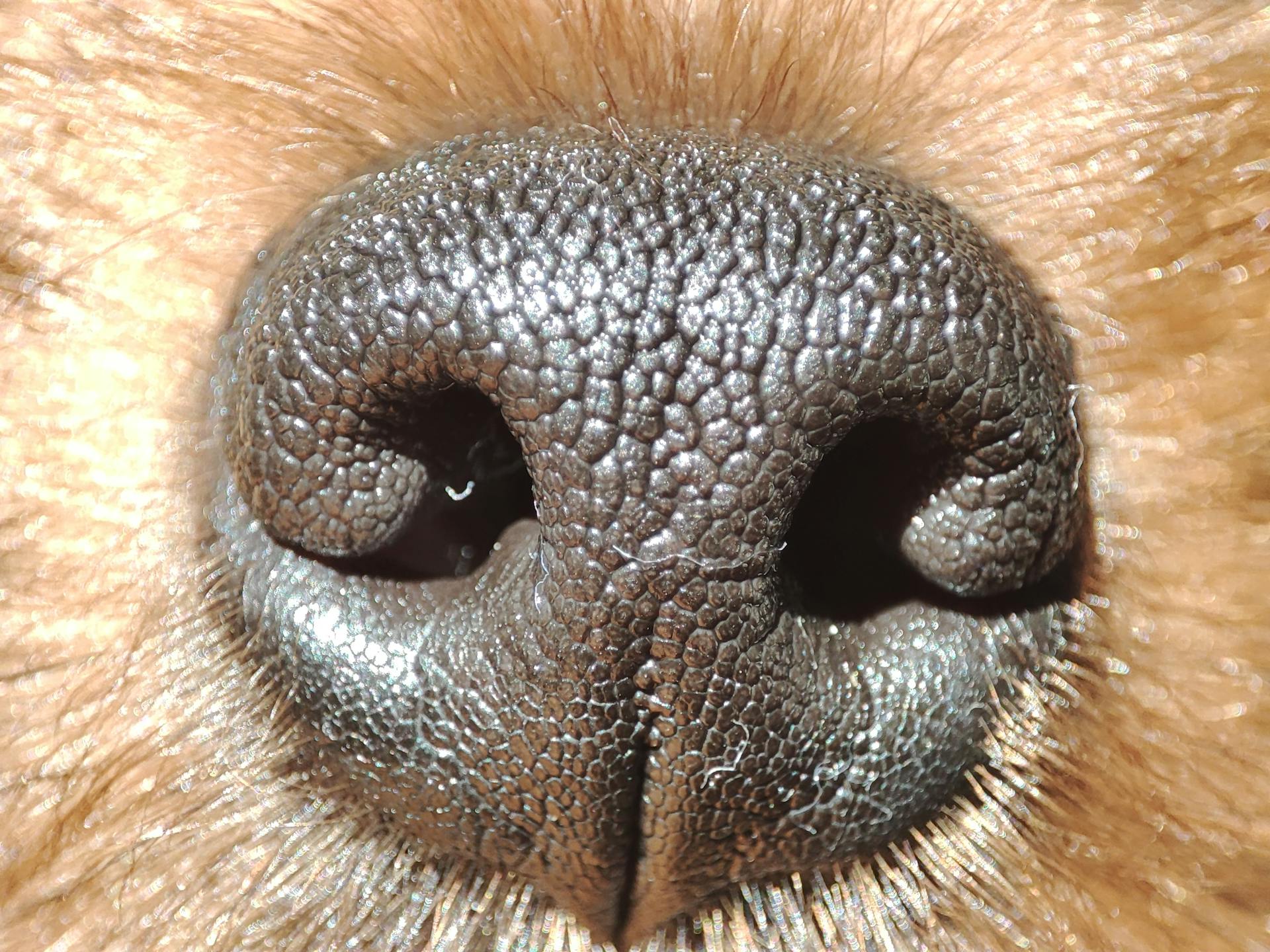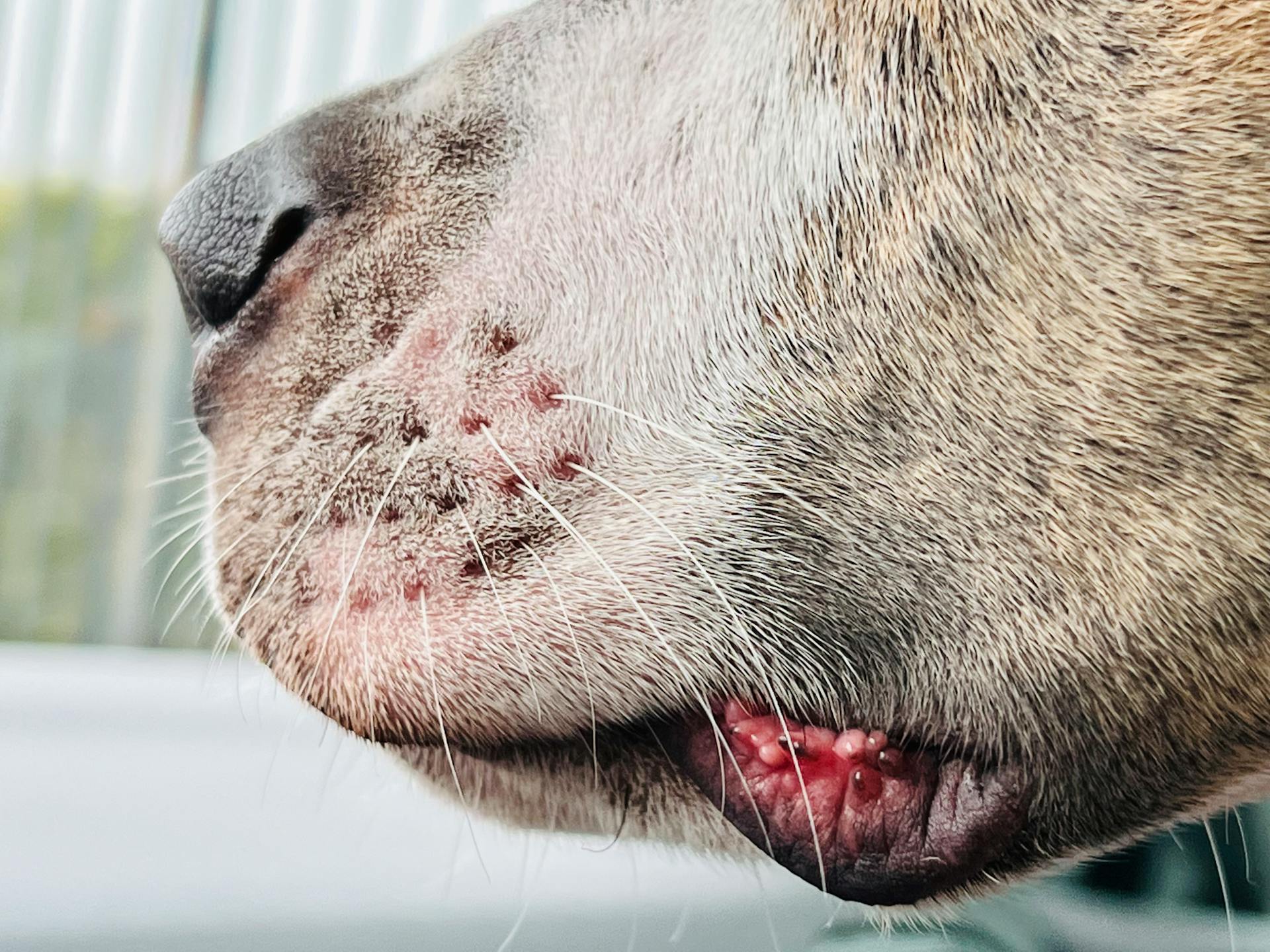
Dog skin disorders can be a real challenge for our furry friends. Redness, itching, and scratching are common symptoms that can indicate a skin problem.
Common skin disorders in dogs include allergies, flea bites, and skin infections. These conditions can cause a range of symptoms, from mild irritation to severe reactions.
Itching and scratching are two of the most common signs of a skin disorder. If your dog is constantly scratching or licking their skin, it's a good idea to take a closer look.
Skin disorders can be caused by a variety of factors, including allergies, genetics, and environmental factors.
Take a look at this: Allergies for Dogs Scratching
Causes and Types
Skin problems in dogs are often caused by allergies, which are the most common cause. Allergies can lead to skin issues like allergic dermatitis.
There are several other potential causes of skin problems in dogs, including sensitivities, parasites, and thyroid issues. These underlying causes can lead to a range of skin issues.
Some common skin problems in dogs include ear mites, staph infections, yeast infections of the skin or ears, fleas, ticks, demodectic mange, and sarcoptic mange. These skin issues can be caused by various factors, including parasites and allergies.
Here are some common causes of skin problems in dogs:
- Allergies
- Sensitivities
- Parasites
- Thyroid issues
Some common skin problems in dogs include:
- Allergic dermatitis
- Ear mites
- Staph infections
- Yeast infections of the skin or ears
- Fleas
- Ticks
- Demodectic mange
- Sarcoptic mange
- Skin problems brought on by autoimmune diseases
Atopic Dermatitis and Allergies
Atopic dermatitis is a chronic and hereditary allergic skin disease that affects dogs, often starting between 6 months and 3 years of age. Some breeds, like the golden retriever, can show signs even earlier.
Dogs with atopic dermatitis are itchy, especially around the eyes, muzzle, ears, and feet, and in severe cases, the irritation can be generalized. If the allergens are seasonal, the signs of irritation will be similarly seasonal.
Many dogs with house dust mite allergy have perennial disease, and some common allergens associated with atopy in dogs include pollens of trees, grasses, and weeds, as well as molds and house dust mites.
Additional reading: Can Dogs Have Seasonal Allergies
Dogs with atopic dermatitis often present with erythema, and the axillae, ventral abdomen, distal extremities, inner pinnae, periocular, perioral, and perianal regions are commonly affected.
Here are some common signs and symptoms of atopic dermatitis:
- Red, irritated or flakey skin
- Scooting or rubbing on surfaces
- Sores
- Hair loss
- Rubbing of face or ears
- Excessive scratching
- Excessive licking
- Chewing or biting the skin
If you suspect your dog has atopic dermatitis, it's essential to consult a veterinarian for proper diagnosis and treatment.
Infectious and Ectoparasitic Diseases
Infectious and ectoparasitic diseases can cause a range of skin problems in dogs. One of the most common contagious parasitic skin diseases is Sarcoptic mange (scabies).
Dogs can also be infested with contagious lice, and other ectoparasites like fleas and ticks can be acquired from an environment where other infested hosts have established the parasite's life cycle. Ringworm is a fungal infection that can be contagious to other dogs as well as humans.
Symptoms of ringworm can include hair loss on the infected area, itchiness, and ringed lesions. It tends to occur more in puppies than adult dogs, and is not a life-threatening condition but requires a veterinarian visit to confirm the diagnosis and prescribe treatment.
Here's an interesting read: Can Dogs Develop Allergies Later in Life
Cutaneous Manifestations of Internal Diseases
Some systemic diseases can become symptomatic as a skin disorder. These include many endocrine (hormonal) abnormalities.
Hypothyroidism can cause skin symptoms such as dry skin and hair loss. Cushing's syndrome, or hyperadrenocorticism, can lead to skin thinning and easy bruising.
Tumors of the ovaries or testicles can also manifest as skin disorders.
Ectoparasites
Ectoparasites are external parasites that can infest dogs and cats, causing a range of skin problems. Fleas are one of the most common ectoparasites, and their bites can lead to flea allergy dermatitis, which causes intense itching and skin irritation.
Fleas can be found on the skin, particularly in areas where the skin is thin, such as the lumbosacral area, tail base, and ventral abdomen. In cats, fleas can also cause miliary dermatitis, a condition characterized by small, scaly lesions.
Mites, such as sarcoptic and notoedric mites, can also infest dogs and cats, causing intense itching, papules, and crusts. These mites tend to infest areas such as the ear margins, face, elbows, and ventral abdomen.
A unique perspective: Pyotraumatic Dermatitis
Demodicosis, caused by Demodex mites, typically results in alopecia, scaling, and comedones, and can be found on the face and feet. Cheyletiellosis, caused by Cheyletiella mites, produces excessive scaling and pruritus, often referred to as "walking dandruff."
Other ectoparasites, such as lice and nits, can also infest dogs and cats, and are frequently visible on the hair or skin.
Here are some common signs of ectoparasite infestations:
- Excessive itching and scratching
- Skin lesions and crusts
- Alopecia (hair loss)
- Excessive scaling
- Pruritus (itching)
It's essential to perform flea combing on every pruritic dog and cat to detect ectoparasites, and to inspect the skin regularly for signs of infestation.
Acral Lick Granulomas
Acral lick granulomas are raised, usually ulcerated areas on a dog's extremity caused by the dog's own incessant, compulsive licking.
Compulsive licking is defined as licking in excess of that required for standard grooming or exploration, and represents a change in the animal's typical behavior and interferes with other activities or functions.
This excessive licking can be difficult to interrupt, and it's not uncommon for dogs to lick in a way that prevents them from eating, drinking, playing, or interacting with people.
The constant licking can lead to raised, usually ulcerated areas on the dog's extremity, which are known as lick granulomas.
Readers also liked: Lick Granuloma vs Hotspot
Symptoms and Clinical Signs
Dogs with skin disorders often exhibit a range of symptoms, from mild to severe.
Excessive scratching is a common sign that your dog is experiencing some type of skin condition. If you notice your dog scratching excessively, it's a good idea to have them checked by a vet.
Red, irritated, or flaky skin can be a symptom of dog skin allergies. This can be accompanied by hair loss, which is a common symptom of skin conditions in dogs.
Dogs with skin allergies may also exhibit unusual behaviors such as scooting or rubbing on surfaces. This is often due to discomfort or itching.
Some common symptoms of skin conditions in dogs include hair loss, skin lesions, redness, and raised bumps on the skin. These symptoms can be caused by a variety of factors, including skin allergies and flea allergy dermatitis.
Regularly inspecting your dog for flea dirt (feces) can help identify flea allergy dermatitis. This condition can result in incredibly itchy skin, especially at the base of the tail.
Here are some common symptoms of skin conditions in dogs:
- Hair loss
- Skin lesions
- Redness
- Raised bumps on the skin
- Ear infections
- Scabs
- Diarrhea or other gastrointestinal issues
In severe cases, skin allergies can lead to secondary infections, such as yeast and bacterial infections. These infections can invade through sores, causing infections to develop.
Diagnosis and Treatment
Diagnosis of dog skin disorders can be a complex process, but a thorough history is essential to rule out drug-induced conditions and parasitic causes. A skin biopsy, the only way to truly diagnose an autoimmune skin problem, may be required if other causes are eliminated.
A veterinarian may offer to try steroids first, but this can skew results and make diagnosis more challenging. Steroids can't be used for 14 to 21 days before a biopsy is taken, or the histology will be altered and may lead to an incorrect diagnosis.
Treatment for dog skin disorders often involves a combination of medications, including glucocorticoids (steroids) and immunosuppressive medications. These medications can have side effects, such as increased drinking and urinating, and may lead to problems like diabetes mellitus and Cushing's disease.
Here are some common skin problems in dogs and their treatments:
- Allergic dermatitis: treated with injectable, non-steroidal medications, medicated baths, laser treatments, and other options.
- Ear mites: treated with antibiotics and medicated ear drops.
- Staph infections: treated with antibiotics.
- Yeast infections: treated with antifungal medications.
- Fleas and ticks: treated with topical medications and flea preventatives.
It's essential to note that some skin problems are incurable, but they can be managed with proper treatment. Curable skin conditions include staph infections, bacterial infections, and parasites.
Diagnosis

Diagnosis is a crucial step in determining the cause of your dog's skin problems. A thorough history is important to rule out any possible drug-induced conditions.
Parasitic conditions should also be eliminated as causes of the skin lesions. A skin biopsy is the only way to truly diagnose an autoimmune skin problem, but it can be complicated.
The ideal biopsy should capture a vesicle or pustule before it erodes. Unfortunately, these are very delicate lesions and are rarely found intact in time to do a biopsy.
Steroids can't be used for 14 to 21 days before the biopsy is taken, or the histology will be altered and may lead to an incorrect diagnosis.
A veterinarian may recommend various tests, including skin cytology, to diagnose the problem. Skin cytology involves scraping the skin's surface with a dull blade to remove flakes, which are then examined under a microscope.
The most common skin problems in dogs include:
- Allergic dermatitis
- Ear mites
- Staph infections
- Yeast infections of the skin or ears
- Fleas
- Ticks
- Demodectic mange
- Sarcoptic mange
- Skin problems brought on by autoimmune diseases, including lupus and pemphigus
Performing a physical exam is the first step in diagnosing dog skin conditions. In some cases, this exam tells us everything we need to know.
Treatment

Treatment for your dog's skin condition will depend on the underlying cause, but there are some general steps your veterinarian will take.
Your veterinarian will likely start with a combination of medications, including glucocorticoids like prednisone, to help reduce inflammation and itching. They may also prescribe immunosuppressive medications like azathioprine or cyclosporine to help calm the immune system.
In some cases, topical steroids or immunomodulators like tacrolimus may be used to treat mild or localized skin problems. Antibiotics may also be prescribed to treat secondary bacterial infections.
If your dog has a food allergy, your veterinarian may recommend a food trial to identify the specific allergen causing the problem. This involves feeding your dog a novel protein source, such as venison or salmon, for a period of time to see if symptoms improve.
Some dogs may require pulse therapy, which involves administering large doses of steroids intermittently to help manage symptoms.
For another approach, see: How to Treat Fading Puppy Syndrome at Home

Here are some common treatment options for skin conditions in dogs:
It's essential to work closely with your veterinarian to determine the best course of treatment for your dog's skin condition. Regular follow-up appointments will be necessary to monitor progress and adjust treatment as needed.
Curious to learn more? Check out: Lick Granuloma Dog Home Treatment
Frequently Asked Questions
What does pyoderma look like on a dog?
Pyoderma in dogs typically presents as red, raised papules or pustules with a white pus-filled center, often resembling human pimples. Additional signs may include crusty lesions, dry skin patches, hair loss, and intense itching.
What does a skin disease look like on a dog?
A skin disease in dogs can manifest as excessive scratching, redness, hair loss, and unusual odors, often accompanied by visible signs such as scabs, lumps, and flaky skin. If you notice any of these symptoms, it's essential to consult a veterinarian for proper diagnosis and treatment.
What are these crusty scabs on my dog's skin?
Crusty scabs on your dog's skin can be caused by various factors, including allergies, injuries, or excessive scratching. Learn more about common reasons behind scabs and how to address them for your furry friend's comfort and health
Sources
- https://en.wikipedia.org/wiki/Dog_skin_disorders
- https://www.vet.cornell.edu/departments-centers-and-institutes/riney-canine-health-center/canine-health-information/canine-skin-autoimmune-diseases
- https://todaysveterinarypractice.com/dermatology/diagnosing-common-skin-conditions-of-dogs-and-cats-in-community-medicine-practice/
- https://www.modestovethospital.com/site/blog/2021/12/01/skin-allergy-in-dogs
- https://www.allcreaturesca.com/services/dogs/dog-skin-problems
Featured Images: pexels.com


